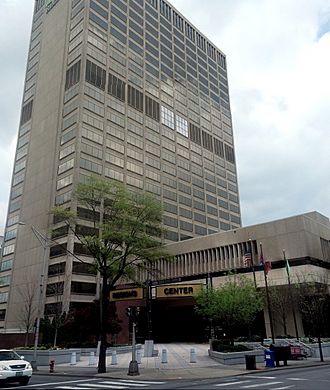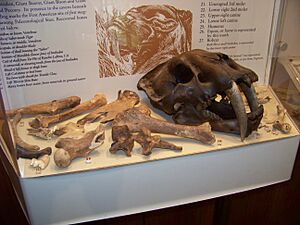UBS Tower (Nashville) facts for kids
Quick facts for kids UBS Tower |
|
|---|---|
 |
|
| General information | |
| Type | office |
| Architectural style | International Style |
| Location | 315 Deaderick Street Nashville, Tennessee United States |
| Coordinates | 36°09′57″N 86°46′47″W / 36.1659°N 86.7796°W |
| Completed | 1974 |
| Height | |
| Roof | 354 ft (108 m) |
| Technical details | |
| Floor count | 28 |
| Floor area | 602,348 sq ft (55,960.0 m2) |
The UBS Tower is a tall building in Nashville, Tennessee. It stands 108 meters (354 feet) high and has 28 floors. This skyscraper is located at 315 Deaderick Street. It was finished in 1974.
The building has had a few names over the years! It was first called the First American Center. Its name changed when First American National Bank joined with AmSouth Bank. Later, it became the Regions Center when AmSouth joined with Regions.
For a long time, this building was the main office in Tennessee for Regions Bank. Even though Regions Bank moved in 2013, they still rent a large part of the building. Today, a big Swiss banking company called UBS rents space there. They moved some of their office jobs to downtown Nashville. Because of this, the building's name changed again to UBS Tower.
Many different businesses rent offices on the upper floors of the UBS Tower. There is also a small parking garage under the building.
Contents
Discovering Ancient History
The land where the UBS Tower stands became famous in 1971. This was when workers found bones of a saber-toothed cat while digging for the building's foundation!
Many famous archaeologists came to see the site. These experts study old things to learn about the past. They included Ronald Spores, Kent Flannery, Vance Haynes, and Edwin Williamson. John Guilday, from the Carnegie Museum of Natural History, studied all the animal bones found. He shared his findings in a science journal in 1977.
Dating the Discoveries
Scientists used a method called radiocarbon dating to find the age of the bones. Human remains found in the cave were about 1,690 to 2,390 years old. These human bones were from the Woodland Period and were found much higher up than the saber-toothed cat bones. This means the humans lived thousands of years after the saber-toothed cat.
The saber-toothed cat bones were dated to about 9,410 to 10,035 years ago. This is very late for saber-toothed cats to be in the Southeast United States. It means they lived around the same time as early Paleoindian people along the Cumberland River. Because of this, some scientists are a bit unsure about these exact dates for the saber-toothed cat.
Preserving the Cave
Because the discovery was so interesting, First American Bank decided to protect the small part of the cave that was not destroyed. They built steel and concrete over these cave parts. This created a special hidden space under the lowest parking level. There was even a way to get in with a hatch and a ladder.
Newspapers and magazines in the 1970s showed that archaeologists really wanted to dig more in the cave. In 1973, Time Magazine even said the bank was "preparing to let archaeologists resume their digging." Sadly, it seems these plans were stopped once the building was finished. The last mention of more digging was in 1976.
Later Visits to the Cave
In 1978, a group of cavers from Nashville visited the site. But they were disappointed because there wasn't much of the cave left. The next time anyone officially entered the cave was in 2008. This was when archaeologists from Tennessee's Division of Archaeology came back to study it.
Saber-Toothed Cat Display
For many years, Regions Bank and UBS had a special display in their lobby. It showed bones from the saber-toothed cat and other animal remains found at the site. In 2016, this display moved to Bridgestone Arena.
The display includes parts of the saber-toothed cat's jaw, teeth, ribs, and leg bones. There is also a copy of a saber-toothed cat skull from the La Brea Tar Pits. The original saber-toothed cat tooth that was found in 1971 is not on display. People thought it was at the Smithsonian museum, but the museum has no record of it.
A Mascot is Born
The discovery of the saber-toothed cat bones was very important for Nashville. It inspired the logo for the Nashville Predators hockey team! Their mascot is even named Gnash, after the saber-toothed cat.
In the team's early years, a video was shown before each home game. It showed a computer-made saber-toothed cat coming out of the ground under downtown Nashville. Then, the team would skate onto the ice!


